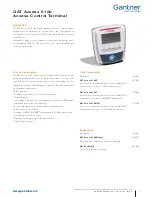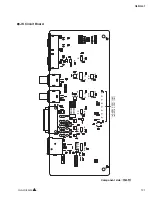
3
PREPARING TO CHARGE EXTERNAL BATTERY
When the unit is being used to charge an external battery, it is being used as a “Parallel Charger”. Most of the chargers output goes to charge the
most discharged battery until both batteries are equally charged, and then both batteries charge up together. To charge external batteries, it is
important to have the internal battery fully charged.
Take the following steps to prepare an external battery for charging.
1.
If necessary to remove battery from vehicle to charge, always remove the grounded terminal from the battery first. Make sure all accessories
in the vehicle are off, so as not to cause and arc. If battery is removed from vehicle, see “CHARGING BATTERY OUTSIDE VEHICLE” section.
Note:
A battery installed in a boat must be removed and charged on shore. To charge it on board requires equipment specially designed for
marine use.
2.
Be sure battery posts are clean. Be carefully to keep corrosion from coming in contact with eyes.
3.
Be sure the area around the battery is well ventilated while the battery is being charged. Gas can be forcefully blown away by using a piece of
cardboard or other non-metallic material as a fan.
4.
Add distilled water in each cell until battery acid reaches level specified by the battery manufacturer. This helps purge excessive gas from
cells. Do Not Overfill
5.
If battery does not have cell caps, check manufacturer’s instructions for check water level.
6.
Replace filler caps.
7.
Locate the charger as far away from the battery as the DC cables permit.
8.
Do not charge a frozen battery. Trapped gases in battery may cause it to explode.
9.
Do not set battery on top of charger.
CHARGING BATTERY INSIDE VEHICLE
When battery to be charged is installed in a vehicle, connect clamps to battery as outlined in section “ENGINE STARTING INSTRUCTIONS”. See
“RECHARGE INTERNAL BATTERY” for charging operating instructions.
Note:
Charger will be charging the Internal Battery while the DC clamp switch is in the OFF position. Only when the DC clamp switch is turned to
the ON position will charging begin on the External Battery.
CHARGING BATTERY OUTSIDE A VEHICLE
Follow these steps when battery is outside vehicle:
1.
Check polarity of battery post. Positive (POS, P, +) battery post usually has a larger diameter than Negative (NEG, N, -) post.
2.
Attach at least a 24 inch long, 6 gauge insulated battery cable to the negative battery post.
3.
Set DC clamp switch to OFF position.
4.
Connect Positive (Red) clamp to positive post of battery.
5.
Touch or connect Negative (Black) clamp to far end of cable attached to Negative post. If light comes on, the positive
clamp and cable are on the incorrect post and should be switched. Repeat test, if light does not come on.
6.
Position yourself and the free end of cable as far away from battery as possible. Do not face the battery when making
the final connection.
7.
Connect Negative (Black) charger clamp to free end of cable.
8.
Connect AC cord. See “RECHARGE INTERNAL BATTERY” for charging operating instructions.
9.
Set DC clamp switch to ON position. MAKE SURE POLARITY LIGHT IS OFF BEFORE TURNING UNIT ON. Do not face the battery when
turning the DC clamp switch to the ON position.
Note:
Charger will be charging the Internal Battery while the DC clamp switch is in the OFF position. Only when the DC clamp switch is turned
to the ON position will charging begin on the External Battery.
10. When disconnecting charger, set the DC clamp switch to OFF and disconnect AC cord before disconnecting the clamps. Always disconnect
clamps in reverse sequence of connecting procedure and break first connection as far away from battery as practical.
STORING AND TRANSPORTING
Always store and transport the unit in an upright position. If the unit is laid on its back, electrolyte will leak out of the battery and cause serious
damage. THE TILT CREATED BY WHEELING THE UNIT AROUND WITH THE HANDLE WILL NOT CAUSE ELECTROLYTE TO LEAD FROM
THE BATTERY IF IT HAS NOT BEEN OVER FILLED.
The unit should always be stored indoors in a warm place. A battery at 0°F has only 40% the starting capacity of a battery stored at 80°F.
ALWAYS STORE THE OUTPUT CLAMPS ON THE INSULATED STORAGE BAR. THE CLAMPS SHOULD NOT TOUCH THE METAL HANDLE.
NEVER ATTACH THE CLAMPS ON THE HANDLE. NEVER LET THE CABLES DANGLE AND TOUCH THE CABINET. NEVER ATTACH THE
CLAMPS TO THE CABLE INSULATION.
ATTACHING CLAMPS TO METAL HANDLE, ATTACHING CLAMPS TOGETHER OR SHORTING CLAMPS IN ANY MANNER WILL DAMAGE
THE UNIT AND MAY CAUSE PERSONAL INJURY.
If clamps are accidentally attached to the metal or short circuited in another manner immediately disconnect the clamps or set the DC clamp switch
to the OFF position.
MAINTENANCE
To obtain maximum, reliable safe service from the unit, it is important that routine maintenance be performed on the unit.
ONCE A MONTH:
•
Inspect output clamps. If jaws are worn of insulation burned, clamps should be repaired or replaced.
•
Check AC cord and DC cables for damage. If insulation is cracked or broken, cord should be replaced.
•
Touch jaw of Negative Clamp to jaw of Positive Clamp. If battery is fully charged and light does not come on, Polarity light should be replaced.
•
Battery liquid level should be checked in each cell, if possible. Water should be added to any cell where liquid is low. Do not overfill. Check
battery case for cracks and leaks.
•
Check that all battery hold down straps, are tight.
•
Check that screws, which hold cables to battery terminals, are tight.






















